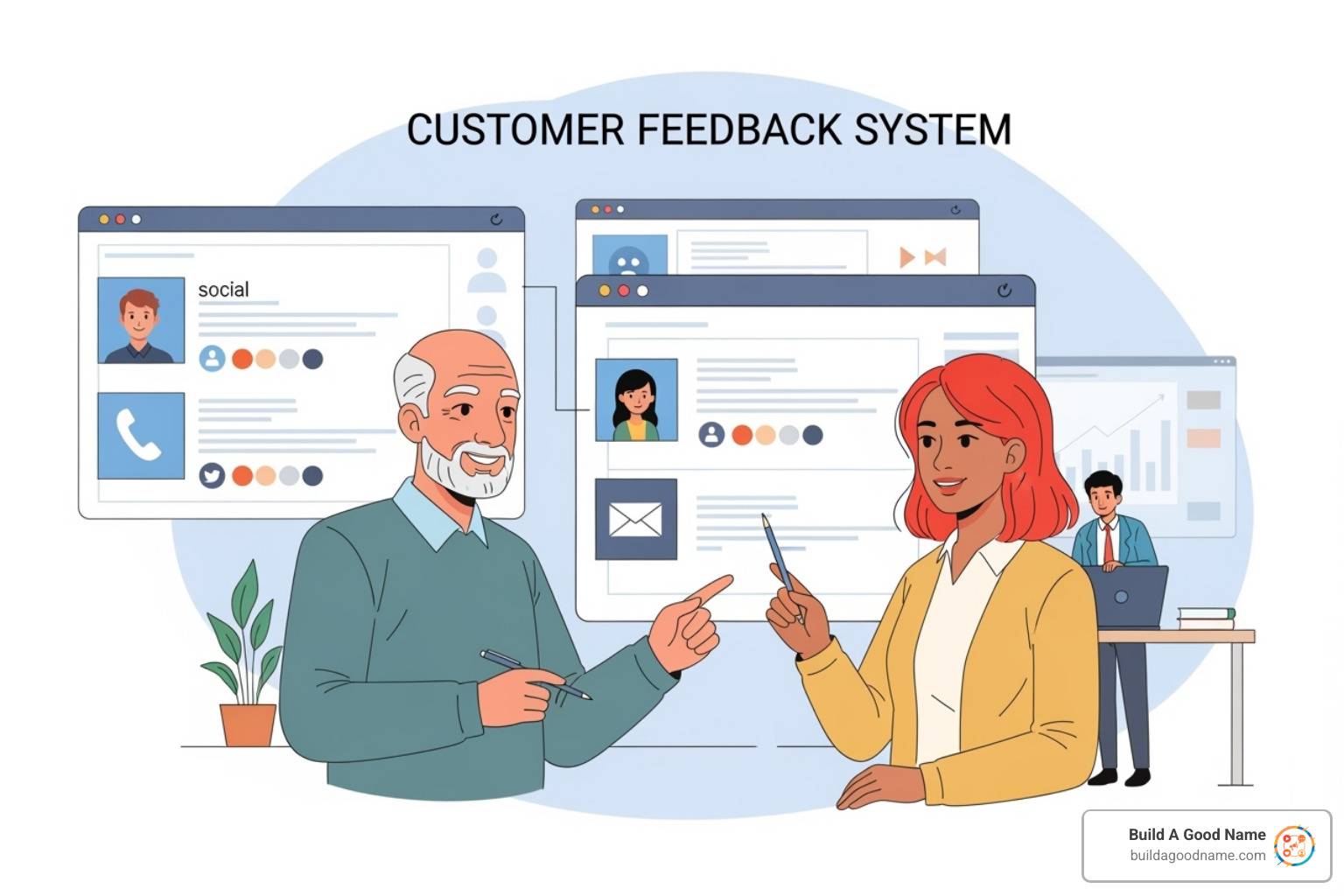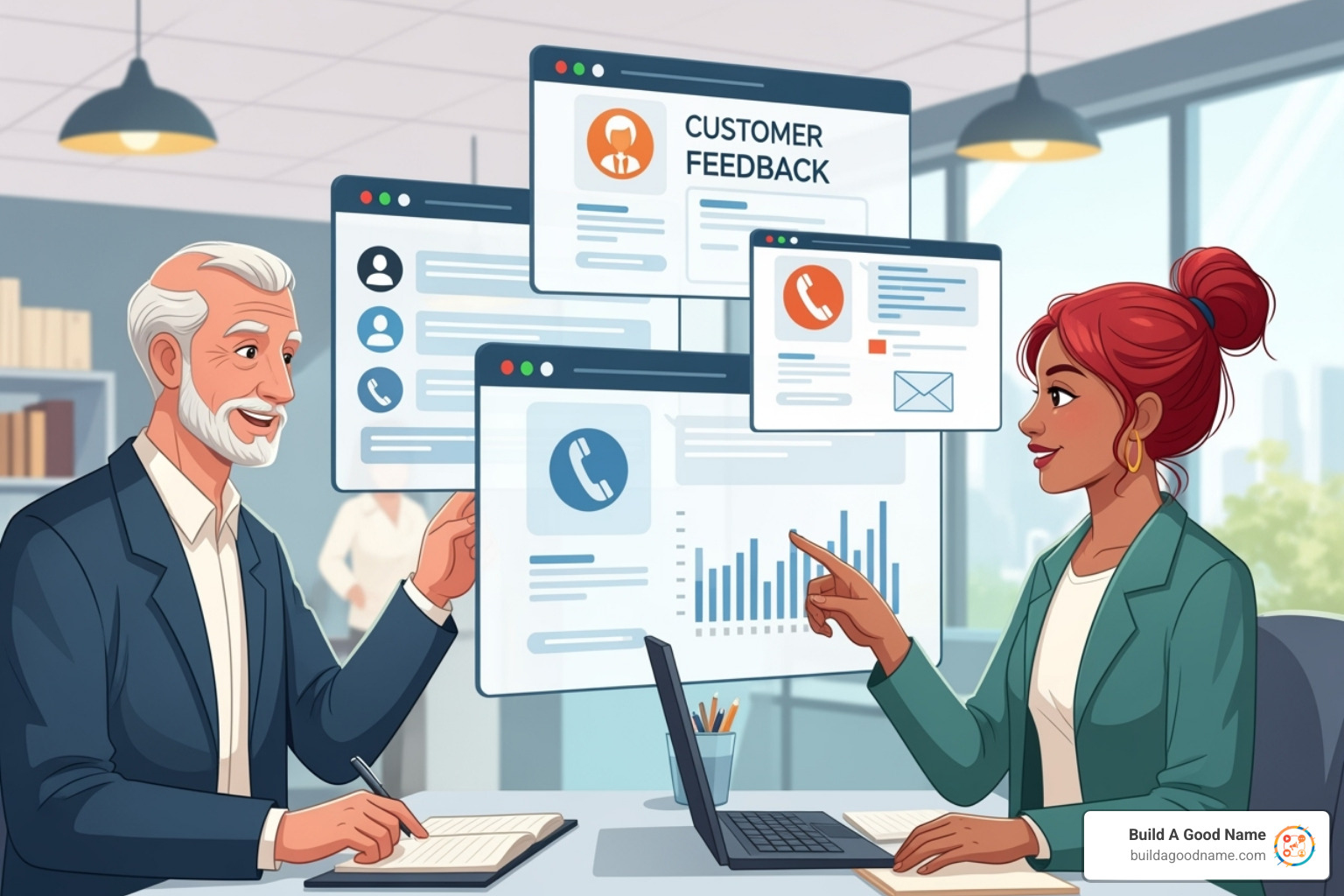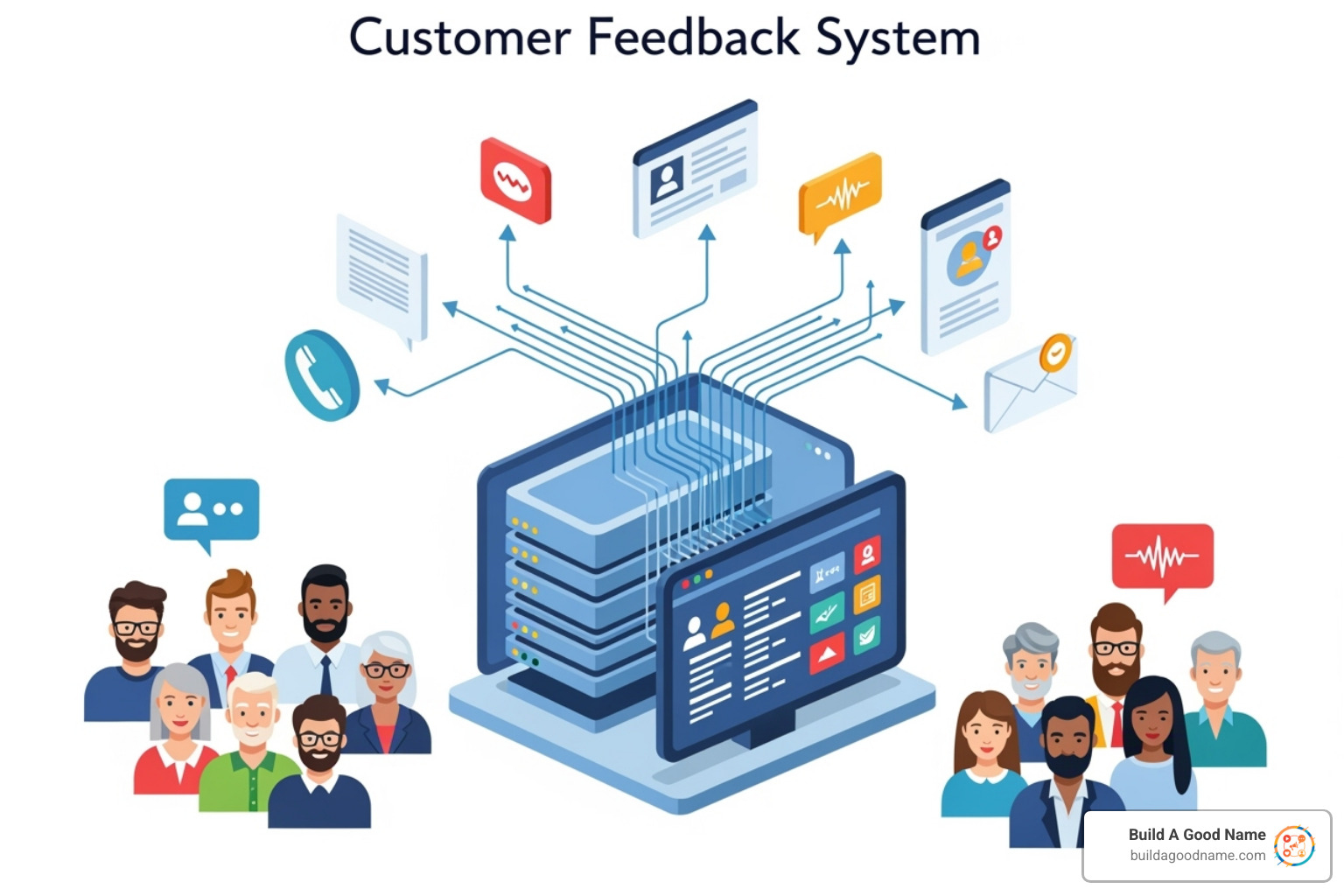Why Customer Feedback Systems Are Essential for Local Business Success
What Is a Customer Feedback System and Why Is It Essential?
A customer feedback system is more than a comment box – it is a structured, repeatable process for turning scattered opinions into insights you can act on. In practice, that means:
- Collecting feedback at every touch-point (online reviews, surveys, chats, social posts).
- Organizing the data in one hub so nothing slips through the cracks.
- Analyzing trends to spot what truly matters to customers.
- Implementing improvements and letting customers know you listened.
Why bother? Because 96 % of dissatisfied customers never complain directly – they just leave. A proactive system gives them a voice before they churn, strengthens your reputation, and helps employees focus on what customers value most.
Industry research backs this up: 63 % of consumers feel companies need to listen better. Businesses that do listen are up to 60 % more profitable thanks to higher retention and word-of-mouth.
The Core Purpose: Moving Beyond Guesswork
When you rely on data instead of hunches you can, for example, adjust staffing before long wait-time complaints explode or launch a weekend service because customers explicitly requested it. This data-driven edge is hard for competitors to copy.
Key Types of Customer Feedback to Collect
- Solicited vs. unsolicited – surveys you send vs. opinions customers post on their own.
- Structured vs. unstructured – ratings you can chart vs. open-ended stories that give context.
- Quantitative vs. qualitative – the numbers (“4.5 ★”) vs. the why behind them.
Essential Metrics to Track: NPS, CSAT, and CES
- Net Promoter Score (NPS) – asks “How likely are you to recommend us?” on a 0-10 scale. Aiming for 30 + is a solid target for local businesses. (More background on NPS here).
- Customer Satisfaction (CSAT) – quick 1-5 or 1-10 rating after a transaction.
- Customer Effort Score (CES) – measures how easy it was to get what the customer needed.
Together these three metrics give you a balanced view of loyalty, satisfaction, and friction – the building blocks of long-term growth.
Step 1: Effectively Collecting Feedback Across All Channels
Customers talk about your business everywhere, so your feedback net needs to cover every channel without forcing anyone to jump through hoops. Focus on the moments that matter – right after purchase, after support interactions, and during routine check-ins.
Proactive Collection: Surveys and Direct Outreach

- Post-purchase emails – 2-3 questions while the experience is fresh.
- SMS surveys – 97 % open rate; perfect for a one-question pulse.
- In-app pop-ups – quick, dismissible prompts inside your app or on your site.
- Phone interviews / focus groups – deeper dives when you need rich context.
Need tips on quality responses? See our guide on how to write a good review.
Passive Collection: Listening to the Conversation
- Social media monitoring – track mentions on Facebook, Instagram, X, LinkedIn.
- Online review sites – Google, Yelp, industry directories. Use our Free Online Review Monitoring Tool to stay on top of them.
- Support transcripts & community forums – great for spotting recurring pain points.
One in three consumers now vents on social instead of contacting a business directly – listening there is indispensable.
Step 2: The Customer Feedback Loop – Turning Insights into Action
Collecting feedback is only half the game; closing the loop is where loyalty and growth happen. A simple four-stage cycle keeps you on track:
- Collect & centralize – pull surveys, reviews, chats, and social mentions into one dashboard. Data silos make patterns invisible.
- Analyze & prioritize – use sentiment scoring, tags, and trend charts to find what needs fixing first. Our AI for Business Reviews speeds this up.
- Act & implement – assign owners, adjust processes, update the product, and train staff. Share wins across departments so improvements stick.
- Follow up & close the loop – reply, thank, and publicize the changes. Automated tools like our Automated Review Replies keep responses fast and consistent.

When customers see their suggestions acted on, they transform from critics into advocates – and advocacy is priceless marketing.
Best Practices for Implementing and Managing Your Customer Feedback System
A shiny tool means little without the right habits. Keep these principles front and center:
- Team buy-in – explain why feedback matters and show how each role impacts customer happiness.
- Clear goals – e.g., raise Google rating from 4.2 ★ → 4.5 ★ or cut wait-time complaints by 30 %.
- Real-time visibility for frontline staff – empower them to fix issues on the spot.
- Quarterly system reviews – update surveys, channels, and dashboards as your business scales.
For local-specific advice, visit our guide on Review Management for Local Businesses.
How to Handle Positive and Negative Feedback
| Feedback | Respond within | Must include | Example |
|---|---|---|---|
| Positive | 24-48 h | Thanks + specific detail | “Thanks for pointing out our quick curb-side pickup, Alex! Hope to see you again soon.” |
| Negative | 24 h | Acknowledge, apologize, offer fix | “Sorry about the long wait, Jamie. We’ve added weekend staff – please DM us so we can make this right.” |
Empathy, speed, and ownership turn reviews into relationship moments. More templates: Best Responses to Google Reviews and a 5-Star Review Reply Example.
Key Features to Look for in a Feedback Tool
- Multichannel collection (email, SMS, social, in-store)
- Custom surveys & dashboards
- AI sentiment/trend analysis
- Integrations with your CRM & marketing stack
- Automated workflows for responses and task assignment
- Mobile access & strong data security
See advanced filtering in action with our Review Filtering Tool.
Fostering a Customer-Centric Culture
Leadership must model listening. Share feedback in team huddles, celebrate improvements, and tie customer metrics to KPIs. When everyone sees the direct link between listening and revenue, a customer-first mindset becomes second nature.
Frequently Asked Questions about Customer Feedback Systems
How quickly should you respond to customer feedback?
Speed matters when it comes to customer feedback – but the urgency depends on what type of feedback you’re handling. For negative feedback, aim to respond within 24 hours to show that you take customer concerns seriously and want to make things right quickly.
Think about it from the customer’s perspective: they’ve taken time out of their day to share a complaint, often because they’re frustrated or disappointed. A quick response shows you’re paying attention and care about their experience. This rapid response can often prevent a mildly annoyed customer from becoming truly upset or sharing their negative experience more widely.
Positive feedback deserves attention too, though it’s less urgent. Responding within 24-48 hours to positive reviews and comments reinforces good customer behavior and shows you appreciate their time. While happy customers aren’t going anywhere immediately, acknowledging their praise helps build stronger relationships.
Here’s a practical tip: automation can help you provide immediate acknowledgment while you prepare a more thoughtful, personalized response. A simple automated “thank you for your feedback – we’ll respond personally within 24 hours” message lets customers know their input was received and sets expectations for follow-up.
How do you encourage customers to provide feedback?
Getting customers to share feedback requires making the process as easy and appealing as possible. The biggest barrier to feedback is friction – if it’s complicated or time-consuming, most customers simply won’t bother.
Make it easy by offering multiple channels. Some customers prefer email surveys, others like quick text message links, and some respond well to QR codes on receipts. The more options you provide, the more likely customers are to find a method that works for them.
Timing is everything. Ask for feedback when customers are most likely to have strong opinions and the energy to share them. Post-purchase surveys work particularly well because the experience is fresh in their minds. Just don’t overwhelm customers with feedback requests after every single interaction – that gets annoying fast.
Explain how their feedback gets used to show customers that their input leads to real improvements. When people understand that their opinions actually influence your business decisions, they’re much more motivated to participate. Share examples of changes you’ve made based on customer suggestions.
Small incentives can boost response rates significantly. A 10% discount on their next purchase or entry into a monthly drawing doesn’t cost much but shows you value their time. Keep incentives simple – you don’t want the reward to overshadow the feedback itself.
For more detailed strategies on encouraging quality feedback, check out our guide on The Art of Feedback: How to Write a Good Review That Matters.
What is the difference between a customer feedback system and CRM?
This is a common question that highlights an important distinction between two essential business tools. A CRM (Customer Relationship Management) system is like your customer filing cabinet – it stores customer data, purchase history, contact information, and tracks interactions over time. It’s designed to help you manage ongoing relationships and keep detailed records of who your customers are and what they’ve bought.
A customer feedback system is more like your customer listening post. It’s specifically designed to collect, analyze, and help you act on customer opinions and sentiment. While a CRM might store some feedback data, it’s not built for the specialized tasks of sentiment analysis, feedback categorization, or managing responses to reviews and surveys.
Think of it this way: your CRM might show you that a customer hasn’t purchased anything in six months, but your customer feedback system might reveal that they had a poor experience that caused them to stop buying. The CRM tells you what happened, while the feedback system helps you understand why it happened.
The two systems work beautifully together. Many smart businesses integrate their feedback systems with their CRM to create a complete picture of each customer relationship. This combination gives you both behavioral data (what customers do) and sentiment data (how they feel about what they do).
For example, when you see that a high-value customer left a negative review, you can use your CRM data to understand their purchase history and tailor your response accordingly. This integrated approach helps you provide more personalized service and make better business decisions.
Conclusion: Turn Feedback into Your Most Powerful Asset
Building a customer feedback system might feel overwhelming at first, but it’s actually one of the smartest investments you can make in your business’s future. Think of it as building a bridge between you and your customers – one that lets you hear what they really think and shows them that their opinions matter.
The journey from scattered feedback to systematic improvement isn’t just about collecting more data. It’s about creating a conversation with your customers that never ends. When you actively listen to what they’re telling you and make real changes based on their input, something magical happens. Problems get solved before they become bigger issues. Customers feel valued and heard. Your business starts growing in ways that feel natural and sustainable.
The power of listening goes far beyond just avoiding negative reviews. When customers see that you genuinely care about their experiences, they become your biggest advocates. They tell their friends about businesses that listen. They come back more often. They forgive small mistakes because they know you’ll make things right.
Your customer feedback system becomes like having a crystal ball for your business. It shows you exactly what customers want before your competitors figure it out. It helps you spot trends in your market. It gives you the confidence to make decisions based on real customer needs rather than guesswork.
We know that managing all this feedback can feel like a full-time job on top of everything else you’re already doing. That’s exactly why we created Build A Good Name – to help local businesses like yours turn customer voices into growth without the overwhelming workload.
Our AI Review Replies system handles the time-consuming parts of feedback management while keeping that personal touch your customers appreciate. No more staying up late responding to reviews or worrying that important feedback is slipping through the cracks.
Ready to see real results? Start by learning how to generate more Google reviews and watch as your customer feedback transforms from a source of stress into your most powerful marketing tool.
The businesses that will thrive in the coming years are the ones that master the art of listening. Your feedback system isn’t just about managing reviews – it’s about building relationships that last. Start listening today, and watch your business grow tomorrow.



